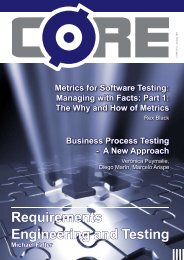Comparison of Change Management Systems
Comparison of Change Management Systems
Comparison of Change Management Systems
You also want an ePaper? Increase the reach of your titles
YUMPU automatically turns print PDFs into web optimized ePapers that Google loves.
44<br />
S<strong>of</strong>tware Engineering<br />
Figure 11 A fictitious Planguage example,<br />
designed to display ways <strong>of</strong> making the<br />
value <strong>of</strong> a requirement clear<br />
For brevity, a detailed explanation is not<br />
given here. Hopefully, the Planguage<br />
specification is reasonably understandable<br />
without detailed explanation. For example,<br />
the Goal statement (80%) specifies which<br />
market (“USA”) and users (“Seniors”)<br />
it is intended for, which set <strong>of</strong> tasks are<br />
valued (the “Photo Tasks Set”), and when<br />
it would be valuable to get it delivered<br />
(“2012”). This ‘qualifier’ information in all<br />
the statements, helps document where,<br />
who, what, and when the quality level<br />
applies. The additional Value parameter<br />
specifies the perceived value <strong>of</strong> achieving<br />
100% <strong>of</strong> the requirement. Of course,<br />
more could be said about value and its<br />
specification, this is merely a ‘wakeup<br />
call’ that explicit value needs to be<br />
captured within requirements. It is better<br />
than the more common specifications <strong>of</strong><br />
the Usability requirement, that we <strong>of</strong>ten<br />
see, such as: “The product will be more<br />
user-friendly, using Windows”.<br />
So who is going to make these<br />
value statements in requirements<br />
specifications? I don’t expect developers<br />
to care much about value statements.<br />
Their job is to deliver the requirement<br />
levels that someone else has determined<br />
are valued. Deciding what sets <strong>of</strong><br />
requirements are valuable is a Product<br />
Owner (Scrum) or Marketing <strong>Management</strong><br />
function. Certainly, the IT staff should<br />
only determine the value related to IT<br />
stakeholder requirements!<br />
Principle 7. Ensure there<br />
is ‘rich specification’:<br />
requirement specifications<br />
need far more information than<br />
the requirement itself!<br />
Far too much emphasis is <strong>of</strong>ten placed<br />
on the requirement itself; and far too<br />
little concurrent information is gathered<br />
about its background, for example: who<br />
wants this requirement and when? The<br />
requirement itself might be less than 10%<br />
<strong>of</strong> a complete requirement specification<br />
that includes the background information.<br />
It should be a corporate standard to specify<br />
this related background information, and<br />
to ensure it is intimately and immediately<br />
tied into the requirement itself.<br />
Such background information is useful<br />
related information, but is not central<br />
(core) to the implementation, and nor is<br />
it commentary. The central information<br />
includes: Scale, Meter, Goal, Definition<br />
and Constraint.<br />
Background specification includes:<br />
benchmarks {Past, Record, Trend},<br />
Owner, Version, Stakeholders, Gist (brief<br />
description), Ambition, Impacts, and<br />
Supports. The rationale for background<br />
information is as follows:<br />
• To help judge the value <strong>of</strong> the<br />
requirement<br />
• To help prioritize the requirement<br />
• To help understand the risks associated<br />
with the requirement<br />
• To help present the requirement in more<br />
or less detail for various audiences and<br />
different purposes<br />
• To give us help when updating a<br />
requirement<br />
• To synchronize the relationships<br />
between different but related levels <strong>of</strong> the<br />
requirements<br />
• To assist in quality control <strong>of</strong> the<br />
requirements<br />
• To improve the clarity <strong>of</strong> the<br />
requirement.<br />
Commentary is any detail that probably<br />
will not have any economic, quality or<br />
effort consequences if it is incorrect, for<br />
example, notes and comments.<br />
See Figure 12 for an example, which<br />
illustrates the help given by background<br />
information regarding risks.<br />
Testability:<br />
Type: Performance Quality.<br />
Owner: Quality Director. Author:<br />
John Engineer.<br />
Stakeholders: {Users, Shops, Repair<br />
Centers}.<br />
Scale: Mean Time Between Failure.<br />
Goal [Users]: 20,000 hours



